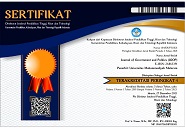Kompleksitas Penanggulangan Kebakaran Hutan Dan Kabut Asap Di Indonesia
Abstract
Keywords
Full Text:
PDFReferences
BARBER, C.V. & SCHWEITHELM, J. (2000). Trial by Fire: Forest Fires and Forestry Policy in Indonesia’s Era of Crisis and Reform. World Resources Institute, Washington, DC, USA.
CHUA, G. (2014). Haze law passed; fines may go up if necessary. The Straits Times. Http://news.asiaone.com/news/singapore/hazelaw- passed-fines-may-go-if-necessary [diakses 6 Agustus 2014 ].
EKADINATA, S., VAN NOORDWI JK, M., BUDIDARSONO, S. & DEWI, S. (2013). Hot Spots in Riau, Haze in Singapore: The June 2013 Event Analysed. ASB Policybrief No. 33. ASB Partnership for the Tropical Forest Margins, Nairobi, Kenya.
Forsyth. T. (2014) “ Public concerns about transboundary haze: a comparison of Indonesia, Singapore, and Malaysia’. doi: 10.106/j.gloenvcha.2014.01013
Francesch-Huidobro, M. (2008). The power of circumvention: Fighting the Southeast Asian forest fires and haze. Governance, politics and the environment: A Singapore study. Singapore: Institute of South East Asian Studies.
GAVEAU, D.L.A., SALIM, M.A., HERGOUALC’H, K., LOCATELLI, B., SLOAN, S.,WOOSTER, M. et al. (2014). Major atmospheric emissions from peat fires in Southeast Asia during non-drought years: evidence from the 2013 Sumatran fires. Scientific Reports,4, 6112.
Ghani, A. (2006, October 12). Yudhoyono says sorry to S’pore. Malaysia for haze. The Straits Times.
Ghani, A. (2007a, June 23). S’pore-Jakarta anti-haze project ‘progressing well’. The Straits Times.
Ghani, A. (2007b, June 20). Singapore and Malaysia update Asean haze plans. Straits Times.
GLOVER, D. &JESSUP, T. (eds) (2006) Indonesia’s Fires and Haze: The Cost of Catastrophe. International Development Research Centre, Ottawa, Canada.
HEIL, A. & GOLDAMMER, J.G. (2001) Smoke-haze pollution: a review of the 1997 episode in Southeast Asia. Regional Environmental Change, 2, 24-37.
Heilmann, D. (2015). After Indonesia’s Ratification: The ASEAN Agreement on Transboundary Haze Pollution and Its Effectiveness As a Regional Environemntal Governance Tool. Journal of Current Southeast Asian Affairs. 34.3, pp. 95-121. Tersedia pada http://nbn-resolving.org/urn/resolver.pl?urn.nbn:de:gbv: 18-4-9073.
HUSSAIN, Z. (2014). Indonesia to merge forestry, environment ministries. The Straits Times. Http://www.asianewsnet.net/Indonesia-to-merge-forestry-environment-ministries-66414.html
IBRAHIM, Z.&HUSSAIN, Z. (2014). Jokowi vows to get tough with haze offenders. The Straits Times. Http://www.straitstimes.com/the-bigstory/ joko-widodo/story/jokowi-vows-get-tough-haze-offenders-20140822
KOH, T. & EWING-CHOW, M. (2013). Haze And The International Insight: The Transboundary Law. The Jakarta Post. Http://www. thejakartapost.com/news/2013/06/27/insight-the-transboundaryhaze- and-international-law.html
Lee Poh Onn (2013). No end in sight to haze dilemma. ISEAS Perspective. (ISSN 2335-6677). 39.
Lestari, Sri. (2015). Dampak kabut asap diperkirakan capai Rp.200 Trilliun. https://www.bbc.com/indonesia/berita_indonesia/2015/10/151026_indonesia_kabutasap
Lin. Y., Wijedasa, L.S. dan Chisholm, R. A. (2015). Singapore’s willengness to pay for mitigation of transbiundary forest-fire haze from Indonesia. Environmental Letters. Volume 12. No. 2
LOHMAN, D.J., BICKFORD, D. & SODHI, N.S. (2007). The burning issue. Science, 316, 376.
Mohd. K. et al. (2017) ‘ An overview of transboundary haze studies: The underlying causes and regional disputes on Southeast Asia Region an Overview of trasnboundary haze studies: The underlying causes and regional disputes on Southeast Asia Region’. (Desember). doi: 10.11113/mjfas.v0n0.719.
MURDIYARSO, D. & ADININGSIH, E.S. (2007).Climate anomalies, Indonesian vegetation fires and terrestrial carbon emissions. Mitigation and Adaptation Strategies for Global Change. 12, 101-112.
PAGE, S.E., SIEGERT, F., RIELEY, J.O., BOEHM, H.-D.V., JAYA, A. & LIMIN, S. (2002). The amount of carbon released from peat and forest fires in Indonesia during 1997. Nature, 420, 61-65.
QUAH, E. (2002). Transboundary pollution in Southeast Asia: the Indonesian fires. World Development, 30, 429-441.
QUAH, E. & VARKKEY, H. (2013). The political economy of transboundary pollution: mitigation of forest fires and haze in Southeast Asia. In The Asian Community: Its Concepts and Prospects (ed. S. Hayashihana), pp. 323-358. Soso Sha, Tokyo, Japan
DOI: https://doi.org/10.31764/jgop.v3i1.5353
Copyright (c) 2021 Geovani Meiwanda, Yusnarida Eka Nizmi
This publication is indexed by:





.png)










1.JPG)